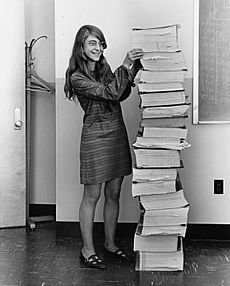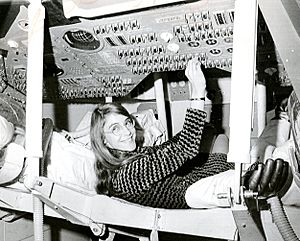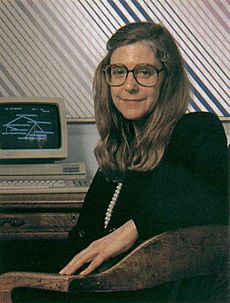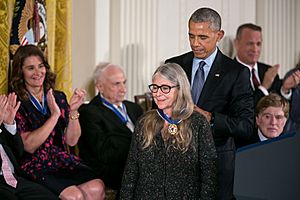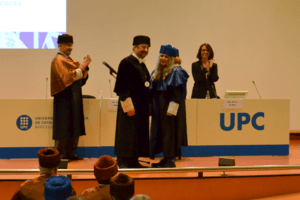Margaret Hamilton (software engineer) facts for kids
Quick facts for kids
Margaret Hamilton
|
|
|---|---|
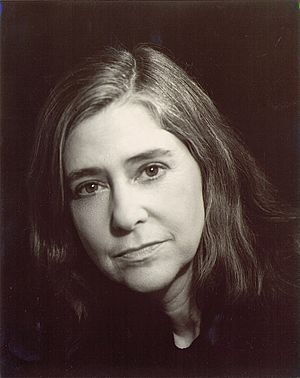
Hamilton in 1995
|
|
| Born |
Margaret Elaine Heafield
August 17, 1936 Paoli, Indiana, U.S.
|
| Education | University of Michigan Earlham College (BA) |
| Occupation | Software engineer |
| Spouse(s) |
|
| Children | 1 |
| Relatives | James Cox Chambers (former son-in-law) |
| Awards | Presidential Medal of Freedom |
Margaret Elaine Hamilton (born August 17, 1936) is a famous American computer scientist and software engineer. She led the team that developed the on-board flight software for NASA's Apollo program. This was the computer code that helped guide the spacecraft to the Moon and back.
Hamilton is also known for creating the term "software engineering". She wanted people to understand that building software was just as important and difficult as building bridges or machines. She later started two successful software companies.
For her amazing work on the Apollo missions, she received the Presidential Medal of Freedom from President Barack Obama in 2016. This is the highest honor a civilian can receive in the United States.
Contents
Early Life and Schooling
Margaret Elaine Heafield was born in Paoli, Indiana, on August 17, 1936. Her family later moved to Michigan, and she graduated from high school in 1954.
She first studied mathematics at the University of Michigan. Later, she went to Earlham College and earned a degree in mathematics with a minor in philosophy in 1958. She was inspired by her math professor, Florence Long, to study abstract math. Her father, who was a poet, and her grandfather, a headmaster, encouraged her to study philosophy.
A Pioneer in Programming
After college, Hamilton moved to Boston. She planned to study more math at Brandeis University. Instead, she took a job at the Massachusetts Institute of Technology (MIT) in 1959.
At MIT, she worked for a famous meteorologist named Edward Norton Lorenz. She wrote software that could predict the weather using early computers. In those days, there were no classes for computer science or software engineering. Programmers like Hamilton had to learn everything on the job.
The SAGE Project
From 1961 to 1963, Hamilton worked on a huge military project called SAGE (Semi-Automatic Ground Environment). She wrote software for a massive computer that the U.S. Air Force used to track airplanes.
She once told a story about her first assignment at SAGE. New programmers were given a program that no one could get to work. The original programmer had made it extra tricky by writing all the comments in Greek and Latin. Hamilton was the first person to figure it out and make it run. This success helped her become a top candidate for her next big job: working for NASA.
Leading the Apollo Software Team
In 1965, Hamilton joined the MIT Instrumentation Laboratory, which was developing the Apollo Guidance Computer. This was the computer that would fly the Apollo spacecraft to the Moon. Hamilton was the first programmer hired for the project and became the leader of the Software Engineering Division.
Her team was in charge of creating the software for the Command Module (the main spacecraft) and the Lunar Module (the lander). The software they wrote had to be perfect. It included special programs to detect errors and recover from them, which Hamilton herself designed.
Her work focused on making software extremely reliable. She developed new techniques for:
- Designing complex systems
- Finding and fixing errors early
- Making sure the software could handle emergencies
- Creating user-friendly interfaces for the astronauts
Saving the Apollo 11 Moon Landing
Hamilton's software played a key role in one of the most famous moments in history: the Apollo 11 Moon landing. Just three minutes before the lunar lander was supposed to touch down, alarms started going off inside the cockpit.
The computer was overloaded with tasks. The astronauts had accidentally left a radar switch on, which was sending too much data to the computer. The computer's alarms, which showed "executive overflows," meant it couldn't do everything at once.
But Hamilton and her team had planned for this. The software was smart enough to know which jobs were most important. It ignored the less important tasks (like the extra radar data) and focused only on what was needed for landing.
An engineer at Mission Control, Jack Garman, recognized the error codes from the software and shouted, "Go, go!" The astronauts continued the landing and safely touched down on the Moon. Without Hamilton's brilliant software design, the mission might have been aborted.
Hamilton later explained:
The computer (or rather the software in it) was smart enough to recognize that it was being asked to perform more tasks than it should be performing. It then sent out an alarm... If the computer hadn't recognized this problem and taken recovery action, I doubt if Apollo 11 would have been the successful Moon landing it was.
Starting Her Own Companies
After her work with NASA, Hamilton continued to be a leader in software. In 1976, she started a company called Higher Order Software. The company created tools to help programmers build software with fewer errors.
In 1986, she founded another company, Hamilton Technologies, Inc. This company was built around a new programming language she invented called the Universal Systems Language (USL).
Legacy and Impact
Margaret Hamilton is famous for coining the term "software engineering". She wanted to make a point that writing software required the same level of skill and discipline as other types of engineering.
When I first came up with the term, no one had heard of it before... It was a memorable day when one of the most respected hardware gurus explained to everyone in a meeting that he agreed with me that the process of building software should also be considered an engineering discipline, just like with hardware.
At the time, software development was not seen as a serious science. Thanks to pioneers like Hamilton, software engineering is now a respected and important field. Her work helped create the core principles of modern computer programming. She is also seen as a role model who helped open the door for more women to succeed in science, technology, engineering, and math (STEM).
Tributes
Hamilton's work has been celebrated in many ways.
- In 2017, LEGO released a "Women of NASA" set that included a minifigure of Margaret Hamilton. The set shows her standing next to a stack of books representing the Apollo software code.
- In 2019, for the 50th anniversary of the Moon landing, Google created a giant tribute to her. They used mirrors at a solar power plant to create a portrait of Hamilton that was visible from the sky.
Awards and Honors
Margaret Hamilton has received many awards for her contributions to science and technology.
- 1986: Augusta Ada Lovelace Award from the Association for Women in Computing.
- 2003: NASA Exceptional Space Act Award for her scientific work. The award included $37,200, the largest cash prize NASA had ever given to one person.
- 2009: Outstanding Alumni Award from Earlham College.
- 2016: Presidential Medal of Freedom, the highest civilian honor in the U.S.
- 2017: Computer History Museum Fellow Award.
- 2018: An honorary doctorate degree from the Polytechnic University of Catalonia.
- 2022: Inducted into the National Aviation Hall of Fame.
Personal Life
Margaret met her first husband, James Cox Hamilton, while they were in college. They married in 1958 and had a daughter named Lauren. They later divorced, and Margaret married Dan Lickly in 1969.
See also
 In Spanish: Margaret Hamilton (científica) para niños
In Spanish: Margaret Hamilton (científica) para niños


